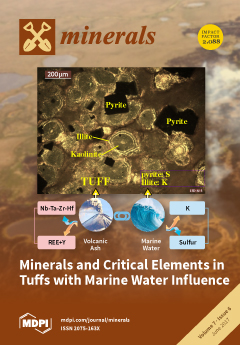Nonpolar hydrocarbon oils are widely used as collectors for floating molybdenite. However, they can only adsorb on molybdenite faces and not on molybdenite edges, resulting in limited molybdenite recovery, especially in processed water containing a high amounts of Ca
2+. In this
[...] Read more.
Nonpolar hydrocarbon oils are widely used as collectors for floating molybdenite. However, they can only adsorb on molybdenite faces and not on molybdenite edges, resulting in limited molybdenite recovery, especially in processed water containing a high amounts of Ca
2+. In this study, the influence of Ca
2+ and pH on the adsorption of polycyclic aromatic hydrocarbons (PAHs), as part of composite collection on molybdenite edges, was studied. It was found that PAHs could only adsorb on molybdenite edges in the presence of Ca
2+. Ca
2+ reacted with molybdenite edges to form CaMoO
4 precipitates. Then, CaMoO
4 precipitates interacted with PAHs to form a structure of π–cation–π by (1) the cation–π interaction, (2) the π–π interaction and (3) the electrostatic interaction. It was also found that CaMoO
4 precipitates on molybdenite edges promoted the adsorption of PAHs. The more the CaMoO
4 precipitates, the easier the PAHs adsorption occurred. As a result, the high amount of Ca
2+and low pH enhanced the adsorption of PAHs on molybdenite edges. This study provides insights into reducing the deleterious effect of Ca
2+ on fine molybdenite flotation.
Full article





